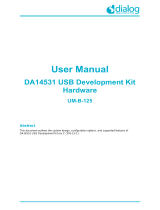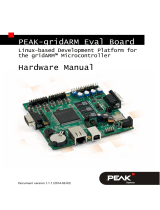Page is loading ...

1
Thermocouples are used to measure temperature
over a wide range. They are used in industry,
laboratories, transport, measuring and control
instrumentation, etc. It also happens that the
measurement should activate an alarm signal if the
temperature is not within the set range, which is an
additional advantage of this thermometer.
Specifications
• 1×6 LCD display
• temperature measuring range: 0...1024°C
400 °C to be measured)
• accuracy of measurement: ±1...2°C
• alarm for set measuring range
(included probe allows a maximum temperature of
• board size 35×116 mm
Circuit description
Thermometer with Thermocouple
and Alarm
Probe included with this unit can measure up to 400°C,
its cable length is 50 cm and the metal cap has an M6
thread. Typical measurement accuracy for
thermocouples is ±1...2°C, which exceeds the required
accuracy for most applications. Visualisation of the
result is realised on a 1x6 LCD display. In practice, for
this type of application, a display with such a small
number of characters is ideal. Communication of the
display with the microcontroller is in 4-bit mode. The
PR1 potentiometer is used to adjust the contrast of
the displayed characters, while the R2 resistor limits
the current flowing through the backlight diodes. For
alarm settings, the thermometer is equipped with
buttons S1 and S2. The alarm is set pressing either
button, with the upper button increasing the
temperature and the lower button decreasing it. Alarm
signal is a modulated sound generated by a buzzer.
Schematic diagram of the thermometer is shown in
Figure 1. Depending on the abilities and needs, the
circuit can be supplied with a DC voltage in the 8...15
V range. The voltage supplied to connector X1 via D1
diode is fed to stabiliser US1, which supplies +5 V.
The operation of the module is controlled by the
ATtiny2313 microcontroller, timed by an internal clock
signal, or more precisely by the program contained
therein. To ensure error-free temperature
measurement, a specialised IC module with integrated
cold-end compensation from Maxim-Dallas MAX6675
is used, which has an SPI interface through which it
communicates with the microcontroller. Due to the
module used, the construction of the thermometer is
extremely simple. The temperature measurement
module can measure temperature in the range
0...1024 °C. It is designed to work with a K-type
thermocouple sensor (chromel-alumel), which is most
commonly used in multimeters.
AVT 1960
ASSEMBLY DIFFICULTY
kits
PDF
DOWNLOAD

2
Fig.1 Schematic diagram
The module must be mounted on the double-sided
PCB shown in Figure 2. Photograph showing the
details of the components arrangement under the
display and the module with the MAX6675 and
thermocouple will facilitate assembly. Begin mounting
by soldering resistors and other small components
onto the board. The next step will be to mount the
thermocouple module, which is fastened with an M2.5
screw with the nut between boards. This mounting
aligns the heights of the angled goldpins of the
module and the main board, thus allowing to sold
them together. The display will be installed as the last
component. Device mounted without any errors, with
efficient components and using a programmed
microcontroller, will work as soon as energized. You
must only adjust the display contrast with the PR1
potentiometer. Each time it is activated, the display
shows the screen as in Figure 3. The same screen and
alarm signal will appear when a sensor is disconnected
from the measuring module or becomes damaged.
During normal operation, the screen in Figure 4 will be
displayed with the measured temperature, while when
one of the buttons is pressed, the screen will switch to
the set limit temperature value which triggers an alarm
(Figure 5).
Fig.2 Arrangement of components on the PCB
LCD 1x6
ATtiny2313
7805
1N4007
uSW
uSW
5V
10k
MAX6675+K
100nF 100nF
100n
220uF 100uF
10k
100
GND
GND
GND
GND
GND
GND
+5V
+5V
+5V
+5V
GNDGND
GND
1
VCC
2
VO
3
RS
4
R/W
5
E
6
D0
7
D1
8
D2
9
D3
10
D4
11
D5
12
D6
13
D7
14
A
15
K
16
DISP1
(SCK)PB7 19
(MISO)PB6 18
(MOSI)PB5 17
PB4 16
(OCI)PB3 15
PB2 14
(AIN1)PB1 13
(AIN0)PB0 12
(ICP)PD6 11
(T1)PD5 9
(T0)PD4 8
(INT1)PD3 7
(INT0)PD2 6
(TXD)PD1 3
(RXD)PD0 2
GND
10
VCC
20
PA0(XTAL1)
5
PA1(XTAL2)
4
PA2(RESET)
1
US2
X1-1
X1-2
GND
IN OUT
US1
D1
31
2 4
S1
31
2 4
S2
- +
SG1
PR1
GND
1
VCC
2
SCK
3
CS
4
SO
5
MOD1
C1 C2
C3
C4 C5
R1
R2
SCK
SCK
MISO
MISO
MOSI
MOSI
SW1
SW1
SW2
SW2
BUZZ
BUZZ
RS
RS
E
E
D4
D4
D5
D5 D6
D6
D7
D7
LCD DISPLAY 6x1
+
+
Mounting and start-up
12

3
R2:..............................................................................100 Ω
Resistors:
R1:..............................................................................10 kΩ
PR1: ………………….mounting potentiometer 10 kΩ
D1:..........................................................................1N4007
DISP1:..................................................................LCD 1×6
US1:.............................................................................7805
X1:......................................................................ARK2/500
SG1: ...................................................................Buzzer 5V
C1-C3: .....................................................................100 μF
S1, S2:...........................................................Microswitch
C5: ............................................................................100 μF
Semiconductors:
Mounting elements
US2:.................................................................ATtiny2313
Capacitors:
MOD1:.........................MAX6675 + thermocouple K
Other:
C4: ............................................................................220 μF
List of components
Photo 1
Fig. 3 Thermometer start screen Fig. 4 Thermometer operating screen Fig. 5 Thermometer settings screen
The self-assembly kits are intended for educational and demonstration purposes only. They are not intended for use in commercial applications. If they are used in such applications, the
purchaser assumes all responsibility for ensuring compliance with all regulations
AVT SPV reserves the right to make changes without prior notice.Installation and connection of the appliance not in accordance with the instructions, unauthorised modification of
components and any structural alterations may cause damage to the appliance and endanger persons using it. In such a case, the manufacturer and its authorised representatives shall
not be liable for any damage arising directly or indirectly from the use or malfunction of the product.
This symbol means do not dispose of your
product with your other household waste.
Instead, you should protect human health
and the environment by handing over your
waste equipment to a designated collection
point for the recycling of waste electrical
and electronic equipment.
Leszczynowa 11 Street,
03-197 Warsaw, Poland
https://sklep.avt.pl/
AVT SPV Sp. z o.o.
kits

4
Notes
/


